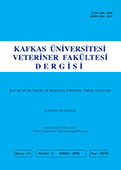
This journal is licensed under a Creative Commons Attribution-NonCommercial 4.0 International License
Kafkas Üniversitesi Veteriner Fakültesi Dergisi
2018 , Vol 24 , Issue 3
P1 Coding Region Diversity of Group VII (Sind-08) Serotype Asia-1 Foot-and-Mouth Disease Virus
1Department of Biological Sciences, Nuclear Institute for Agriculture and Biology (NIAB), Faisalabad, affiliated with Pakistan Institute of Engineering and Applied Sciences (PIEAS), Islamabad, PAKISTAN
DOI :
10.9775/kvfd.2017.18949
In this study, the capsid protein coding region of serotype Asia-1 viruses (n=131) were analyzed, giving importance to the viruses circulating
since 2011 within the Group VII (Sind-08). The isolates recovered during 2011-2017 were found to group within the re-emerging cluster of
Group VII (Sind-08). The time of the most recent common ancestor for this cluster was estimated to be approximately 2004. In comparison to
the older isolates of Group VII (2001-2004), the re-emerging viruses showed variation at fourteen amino acid positions, including substitutions
at the antigenically critical residues VP1140, VP1142 and VP277. In Group VII (Sind-08), all three major antigenic sites have mutations (Site
I and II had four consensus changes at positions 140, 141 and 77, 79 respectively, while site IV had a replacement at position 59) relative to
the internationally recommended vaccine strain (Shamir 89). This study also explains the development and optimization of a new RT-PCR
method that may be employed to amplify and sequence a 2901 base pair (bp) section covering entire capsid coding region (P1) of the FMDV
genome. This method offers a tool that can be employed for antigenic profiling and phylogenetic analyses of FMDV to help vaccine matching
or strain selection in the episode of outbreaks.
Keywords :
Foot-and-mouth disease, Pakistan, Diagnosis, Vaccine










